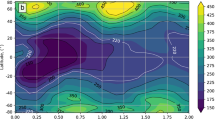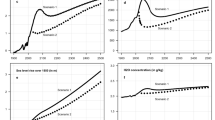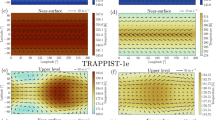Abstract
Models of the climatic perturbation caused by a large scale extraterrestrial impact predict an injection of dust into the stratosphere. This would cause the onset of environmental conditions whose two principal characteristics are a prolonged period of darkness and reduced global temperatures. Similar scenarios follow large scale volcanic eruptions, wildfires and they are predicted for a nuclear winter following a protracted nuclear exchange. A significant drop in temperature and solar insolation are also characteristics of the polar winter. In this paper the onset and emergence from the polar winter is examined as a potential biological framework for studying immediate biological effects following transition into and out of a dark/cold catastrophe. Limitations of the conceptual model, particularly with respect to the fact that polar organisms are well adapted to a regular and severe dark/cold climatic change (which the rest of the Earth's biota is not) are discussed. The model has implications for the poles as an extinction refuge during such climatic changes.
Similar content being viewed by others
References
Ackley, S. F. and Sullivan, C. W.: 1994, ‘Physical Controls on the Development and Characteristics of Antarctic Sea Ice Biological Communities — A Review and Synthesis’, Deep-Sea Res. 41, 1583-1604.
Alvarez, L. W., Alvarez, W., Asaro, F., and Michel, H. V.: 1980, ‘Extraterrestrial Cause of the K / T Extinction’, Science 208, 1095-1108.
Amy, P. S., Pauling, C., and Morita, R. Y.: 1983, ‘Starvation-Survival Processes of a Marine Vibrio’, Appl. Environ. Microbiol. 45, 1041-1048.
Anderson, D. M. and Keafer, B. A.: 1987, ‘An Endogenous Annual Clock in the Toxic Marine Dinoflagellate Gonyaulax tamarensis’, Nature 325, 616-617.
Andreev, A. V.: 1991, ‘Winter Adaptations in the Willow Ptarmigan’, Arctic 44, 106-114.
Antia, N. J. and Cheng, J. Y.: 1970, ‘The Survival of Axenic Cultures of Marine Planktonic Algae from Prolonged Exposure to Darkness at 20 °C’, Phycologia 9, 179-183.
Behrenfeld, M. J. and Falkowski, P. G.: 1997, ‘Photosynthetic Rates Derived from Satellite-Based Chlorophyll Concentration’, Limnol. Ocean. 42, 1-20.
Bratbak, G., Heldal, M., Norland, S., and Thingstad, T. F.: 1990, ‘Viruses as Partners in Spring Bloom Microbial Trophodynamics’, Appl. Environ. Microbiol. 56, 1400-1405.
Cota, G. F., Kottmeier, S. T., Robinson, D. H., Smith, O., and Sullivan, C. W.: 1990, ‘Bacterioplankton in the Marginal Ice Zone of the Weddell Sea: Biomass, Production and Metabolic Activities during Austral Autumn’, Deep-Sea Res. 37, 1145-1167.
Davidson, A. T. and Marchant, H. J.: 1994, ‘The Impact of Ultraviolet Radiation on Phaeocystis and Selected Species of Antractic Marine Diatoms’, in Weiler, C. S. and Penhale, P. A. (eds.), Ultraviolet Radiation in Antarctica: Measurements and Biological Effects, American Geophysical Union, Washington DC, pp. 187-205.
Deacon, G. E. R.: 1982, ‘Physical and Biological Zonation in the Southern Ocean’, Deep-Sea Res. 29, 1-5.
Delille, D.: 1993, ‘Seasonal-Changes in the Abundance and Composition of Marine Heterotrophic Bacterial Communities in an Antarctic Coastal Area’, Polar Biol. 13, 463-470.
Ehrlich, P. R., Sagan, C., Kennedy, D., and Roberts, W. O.: 1984, The Cold and the Dark, Norton and Company, New York, p. 229.
El-Sayed, S. Z. and Taguchi, S.: 1981, ‘Primary Production and Standing Crop of Phytoplankton along the Ice-Edge in the Weddell Sea’, Deep-Sea Res. 28, 1017-1032.
El-Sayed, S. Z., Stephens, F. C., Bidigare, R. R., and Ondrusek, M. E.: 1990. ‘Effect of Ultraviolet Radiation on Antarctic Marine Phytoplankton’, in Kerry, K. and Hempel, G. (eds.), Proceedings of the 5th SCAR Symposium on the Ecological Changes and Conservation of Antarctic Ecosystems, Springer-Verlag, Berlin, pp. 379-385.
El-Sayed, S. Z. and Fryxell, G. A.: 1993, ‘Phytoplankton’, in Friedmann, E. I. (ed.), Antarctic Microbiology, Wiley-Liss, New York, pp. 65-122.
Eppley, R.W.: 1972, ‘Temperature and Phytoplankton Growth in the Sea’, Fish. Bull. 70, 1063-1085.
Fryxell, G. A., Villareal, T. A., and Hoban, M. A.: 1979, ‘Thallassiosira scotia sp. Nov.: Observations on a Phytoplankton Increase in Early Austral Spring North of the Scotia Ridge’, J. Plankton Res. 1, 335-370.
Garrison, D. L. and Buck, K. R.: 1985, ‘Sea-Ice Algal Communties in the Weddell Sea: Species Composition in Ice and Plankton Assemblages’, in Gray, J. S. and Christiansen, M. E. (eds.), Marine Biology of the Polar Regions and Effects of Stress on Marine Organisms, Wiley, New York.
Garrison, D. L.: 1991, ‘Antarctic Sea-Ice Biota’, Amer. Zool. 31, 17-33.
Gerstl, S. A. and Zardecki, A.: 1982, ‘Reduction of Photosynthetically Active Radiation under Extreme Stratospheric Aerosol Loads’, Geol. Soc. Amer. Special Paper 190, 201-210.
Gibson, J. A. E., Garrick, R. C., and Burton, H. R.: 1990, ‘Seasonal Fluctuation of Bacterial Numbers near the Antarctic Continent’, in Proceedings of the NIPR Symposium on Polar Biology, Vol. 3, pp. 16-22.
Gray, D. R.: 1993, ‘Behavioral Adaptations to Arctic Winter: Shelter Seeking by the Arctic Hare (Lepus arcticus)’, Arctic 46, 340-453.
Heath, C. W.: 1988, ‘Annual Primary Productivity of an Antarctic Continental Lake: Phytoplankton and Benthic Algal Mat Production Strategies’, Hydrobiologia 165, 77-87.
Helmke, E. and Weyland, H.: 1995, ‘Bacteria in Sea Ice and Underlying Water of the Eastern Weddell Sea in Midwinter’, Mar. Ecol. Prog. Ser. 117, 169-187.
Hempel, G.: 1985, ‘Antarctic Marine Foodwebs’, in Siegfried, W. R., Condy, P. R., and Laws, R. M. (eds.), Antarctic Nutrient Cycles and Food Webs, Springer-Verlag, Berlin, pp. 266-270.
Holm-Hansen, O., El-Sayed, S. Z., Franceschini, G. A., and Cuhel, R. L.: 1977, ‘Primary Production and the Factors Controlling Phytplankton Growth in the Southern Ocean’, in Llano, G. A. (ed.), Adaptations within Antarctic Ecosystems: Proceedings of the Third SCAR Symposium on Antarctic Biology, Gulf Publishing Company, Houston, TX, pp. 11-50.
Holm-Hansen, O., Mitchell, B. G., Hewes, C. D., and Karl, D. M.: 1989, ‘Phytoplankton Blooms in the Vacinity of Palmer Station, Antarctica’, Polar Biol. 10, 49-57.
Hoshiai, T.: 1969, ‘Seasonal Variation of Chlorophyll a and Hydrological Conditions under Sea Ice at Syowa Station, Antarctica’, Antarctic Record 35, 52-67.
Jablonski, D., Sepkoski, J. J., Bottjer, D. J., and Sheehan, P.M.: 1983, ‘Onshore-Offshore Patterns in the Evolution of Phanerozoic Shelf Communities’ Science 222, 1123-1125.
Johnston, C. G. and Vestal, J. R.: 1991, ‘Photosynthetic Carbon Incorporation and Turnover in Antarctic Cryptoendolithic Communities: Are They the Slowest Growing Communities on Earth?’, Appl. Environ. Microbiol. 57, 2308-2311.
Karl, D. M.: 1993, ‘Microbial Processes in the Southern Oceans’, in Friedmann, E. I. (ed.), Antarctic Microbiology, Wiley-Liss, New York, pp. 1-63.
Kivi, K. and Kuosa, H.: 1994, ‘Late Winter Microbial Communities in the Western Weddell Sea (Antarctica)’, Polar Biol. 14, 389-399.
Knox, G. A.: 1994, The Biology of the Southern Ocean, Cambridge University Press, Cambridge.
Kottmeier, S. T. and Sullivan, C.W.: 1987, ‘Late Winter Primary Production and Bacterial Production in Sea-Ice and Seawater West of the Antarctic Peninsula’, Mar. Ecol. Prog. Ser. 36, 287-298.
Lamb, H. H.: 1977, Climate: Present, Past and Future, Methuen, London.
Lutjeharms, J. R. E., Walters, N. M., and Allanson, B. R.: 1985, ‘Oceanic Frontal Systems and Biological Enhancement’, in Siegfried, W. R., Condy, P. R., and Laws, R. M. (eds.), Antarctic Nutrient Cycles and Food Webs, Springer-Verlag, Berlin, pp. 266-270.
Martin, J. H.: 1989, ‘Glacial-Interglacial CO2 Change: The Iron Hypothesis’, Palaeoceanography 5, 1-13.
Matsuda, O., Ishikawa, S., and Kawaguchi, K.: 1990, ‘Seasonal Variation of Particulate Organic Matter under the Antarctic Fast Ice and Its Importance to Benthic Life’, in Kerry, K. R. and Hempel, G. (eds.), Antarctic Ecosystems, Ecological Change and Conservation, Springer-Verlag, Berlin, pp. 143-148.
Milne, D. H. and McKay, C. P.: 1982, ‘Response of Marine Plankton Communities to a Global Atmospheric Darkening’, Geol. Soc. Amer. Special Paper 190, 297-303.
Mitchell, B. G. and Holm-Hansen, O.: 1991, ‘Observations and Modeling of the Antarctic Phytoplankton Crop in Relation to Mixing Depth’, Deep-Sea Res. 38, 981-1007.
Moyer, C. L. and Morita, R. Y.: 1989a, ‘Effect of Growth Rate and Starvation-Survival on the Viability and Stability of a Psychrophilic Marine Bacterium’ Appl. Environ. Microbiol. 55, 1122-1127.
Moyer, C. L. and Morita, R. Y.: 1989b, ‘Effect of Growth Rate and Starvation-Survival on Cellular DNA, RNA and Protein of a Psychrophilic Marine Bacterium’, Appl. Environ. Microbiol. 55, 2710-2716.
Nelson, D. M., Smith, W. O., Gordon, L. I., and Huber, B. A.: 1987, ‘Spring Distributions of Density, Nutrients and Phytoplankton Biomass in the Ice Edge Zone of the Weddell-Scotia Sea’, J. Geophys. Res. 92, 7181-7190.
Neori, A. and Holm-Hansen, P.: 1982, ‘Effect of Temperature on Rate of Photosynthesis in Antarctic Phytoplankton’, Polar Biol. 1, 33-38.
Nienow, J. A. and Friedmann, E. I.: 1993, ‘Terrestrial Lithophytic Communities’, in Friedman, E. I. (ed.), Antarctic Microbiology, Wiley-Liss, New York, pp. 343-412.
Norris, G.: 1976, ‘Phytoplankton Changes near the Cretaceous-Tertiary Boundary’, in Cretaceous-Tertiary Extinctions and Possible Terrestrial and Extraterrestrial Causes, Syllogeus, National Museum of Canada (by the K-TEC group).
Norton, I. O. and Sclater, J. G.: 1979, ‘A Model for the Evolution of the Indian Ocean and the Breaking Up of Gondwana Land’, J. Geophys. Res. 84B, 6803-6830.
Novitsky, J. A. and Morita, R. Y.: 1976, ‘Morphological Characterization of Small Cells Resulting from Nutrient Starvation of a Psychrophilic Marine Vibrio’, Appl. Environ. Microbiol. 32, 617-622.
Novitsky, J. A. and Morita, R. Y.: 1977, ‘Survival of a Psychrophilic Marine Vibrio under Long-Term Nutrient Starvation’, Appl. Environ. Microbiol. 33, 635-641.
Novitsky, J. A. and Morita, R. Y.: 1978, ‘Possible Strategy for the Survival of Marine Bacteria under Starvation Conditions’, Mar. Biol. 48, 289-295.
Orvig, S.: 1970, Climates of the Polar Regions, Elsevier, Amsterdam.
Palmisano, A. C. and Sullivan, C. W.: 1982, ‘Physiology of Sea Ice Diatoms. I. Response of Three Diatoms to a Simulated Summer-Winter Transition’, J. Phycol. 18, 489-498.
Palmisano, A. C. and Sullivan, C. W.: 1983, ‘Physiology of Sea Diatoms. II. Dark Survival of Three Ice Diatoms’, Can. J. Microbiol. 29, 157-160.
Palmisano, A. C., SooHoo, J. B., Moe, R. L., and Sullivan, C.W.: 1987, ‘Sea Ice Microbial Communities VII. Changes in Under-Ice Spectral Irradiance during the Development of Antarctic Sea Ice Microalgal Communities’, Mar. Ecol. Prog. Ser. 35, 165-173.
Pollack, J. B., Toon, O. B., Ackerman, T. P., McKay, C. P., and Turco, R. P.: 1983, ‘Environmental Effects of an Impact Generated Dust Cloud: Implications for the Cretaceous-Tertiary Extinctions’, Science 219, 287-289.
Pope, K. O., Baines, K. H., Ocampo, A. C., and Ivanov, B. A.: 1994, ‘Impact Winter and the Cretaceous/Tertiary Extinctions: Results of a Chicxulub Asteroid Impact Model’, Earth Planet. Sci. Lett. 128, 719-725.
Potts, M.: 1994, ‘Dessication Tolerance of Prokaryotes’, Microbiol. Rev. 58, 755-805.
Prestrud, P.: 1991, ‘Adaptations by the Arctic Fox (Alopex Lagopus) to the Polar Winter’, Arctic 44, 132-138.
Prevost, J.: 1961, Ecologie du Manchot Empereur, Hermann, Paris.
Prinn, R. G. and Fegley, B.: 1987, ‘Bolide Impacts, Acid Rain, and Biospheric Traumas at the Cretaceous/Tertiary Boundary’, Earth Planet. Sci. Lett. 83, 1-15.
Rampino, M. R., Self, S., and Stothers, R. B.: 1988, ‘Volcanic Winters’, Ann. Rev. Earth Planet. Sci. 16, 73-99.
Rivkin, R. B., Putt, M., Alexander, S. P., Meritt, D., and Gaudet, L.: 1989, ‘Biomass and Production in Polar Planktonic and Sea Ice Microbial Communities: A Comparative Study’, Mar. Biol. 101, 273-283.
Satoh, H., Watanabe, K., Kanda, H., and Takahashi, E.: 1986, ‘Seasonal Changes of Chlorophyll a Standing Stocks and Oceanographic Conditions under Fast Ice near Syowa Station, Antarctica’, Antarctic Record 30, 19-32.
Satoh, H., Fukumi, K., Watanabe, K., and Takahashi, E.: 1989, ‘Seasonal Changes in Heterotrophic Bacteria under Fast Ice near Syowa Station, Antarctica’, Can. J. Microbiol. 35, 329-333.
Schmidt, S., Moskall, W., De Mora, S. J. D., Howard-Williams, C., and Vincent W. F.: 1991, ‘Limnological Properties of Antarctic Ponds during Winter Freezing’, Antarctic Sci. 3, 379-388.
Schnack, S. B.: 1983, ‘On the Feeding of Copepods on Thalassiosira partheneia from the Northwest African Upwelling Area’, Mar. Ecol. Prog. Ser. 11, 49-53.
Seitz, R.: 1986, ‘Siberian Fire as “Nuclear Winter” Guide’, Nature 323, 116-117.
Sepkoski, J. J.: 1982, ‘Mass Extinstions in the Phanerozoic Oceans: A Review’, Geol. Soc. Amer. Special Paper 190, 283-289.
Sheehan, P. M.: 1982, ‘Brachiopod Macroevolution at the Ordovician-Silurian Boundary’, Third N. Am. Paleontol. Conv. Prod. 2, 477-481.
Sieburth, J. M.: 1960, ‘Acrylic Acid, an “Antibiotic” Principle in Phaeocystis Blooms in Antarctic Waters’, Science 132, 676-677.
Sleep, N. H., Zahnle, K. J., Kasting, J. F., and Morowitz, H. J.: 1989, ‘Annihilation of Ecosystems by Large Asteroid Impacts on the Early Earth’, Nature 342, 139-142.
Smith, W. C., Baker, K. S., Fraser, W. R., Hofmann, E. E., Karl, D. M., Klinck, J. M., Quetin, L. B., Prézelin, B. B., Ross, R. M., Trivelpiece, W. Z., and Vernet, M.: 1995, ‘The Palmer LTER: A Long-Term Ecological Research Program at Palmer Station, Antarctica’, Oceanography 8, 77-86.
Smith, W. O. and Nelson, D. M.: 1985, ‘Phytoplankton Bloom Produced by Receding Ice Edge in the Ross Sea: Spatial Coherence with the Density Field’, Science 227, 163-166.
Stanley, S. M.: 1984, ‘Marine Mass Extinctions: A Dominant Role for Temperature’, in Nitecki, M. H. (ed.), Extinctions, University Chicago Press, Chicago, pp. 69-117.
Sverdrup, H. U.: 1953, ‘On Conditions for the Vernal Blooming of Phytoplankton’, Journal du Conseil International pour l'Exploration de la Mer 18, 287-295.
Syvertsen, E. E.: 1985, ‘Resting Spore Formation in the Antarctic Diatoms Coscinodiscus furcatus Karsten and Thalassiosira australis Peragallo’, Polar Biol. 4, 113-119.
Tang, E. P. Y., Tremblay, R., and Vincent, W. F.: 1997, ‘Cyanobacterial Dominance of Polar Freshwater Ecosystems: Are High Latitude Mat-Formers Adapted to Low Temperature?’, J. Phycol. 33, 171-181.
Tevini, M.: 1993, UV-B Radiation and Ozone Depletion, CRC Press, Florida.
Therstein, H. R.: 1981, ‘Late Cretaceous Nanoplankton and the Change at the Cretaceous-Tertiary Boundary’, in Warme, J. et al. (eds.), The Deep Sea-Drilling Project: A Decade of Progress, Soc. Econ. Paleontol. Mineralogists Spec. Pub. 32, 355-394.
Thierstein, H. R.: 1982, ‘Terminal Cretaceous Plankton Extinctions: A Critical Assessment’, Geol. Soc. Amer. Special Paper 190, 385-399.
Tilzer, M. M., Bodungen, B., and Smetacek, V.: 1985, ‘Light-Dependence of Phytoplankton Photosynthesis in the Antarctic Ocean: Implications for Regulating Productivity’, in Siegfried, W. R., Condy, P. R., and Laws, R. M. (eds.), Antarctic Nutrient Cycles and Food Webs, Springer-Verlag, Berlin.
Tilzer, M. M. and Dubinsky, Z.: 1987, ‘Effects of Temperature and Day Length on the Mass Balance of Antarctic Phytoplankton’, Polar Biol. 7, 35-42.
Tilzer, M. M., Elbrächter, M., Gieskes, W.W., and Beese, B.: 1986, ‘Light-Temperature Interactions in the Control of Photosynthesis in Antarctic Phytoplankton’, Polar Biol. 5, 105-111.
Toon, O. B., Pollack, J. B., Ackerman, T. P., Turco, R. P., McKay, C. P., and Liu, M. S.: 1982, ‘Evolution of an Impact-Generated Dust Cloud and Its Effects on the Atmosphere’, Geol. Soc. Amer. Special Paper 190, 187-200.
Toon, O. B., Zahnle, K., Morrison, D., Turco, R. P., and Covey, C.: 1997, ‘Environmental Perturbations Caused by the Impacts of Asteroids and Comets’, Rev. Geophys. 35, 41-78.
Turco, R. P., Toon, O. B., Ackerman, T. P., Pollack, J. B., and Sagan, C.: 1985, ‘Ozone, Dust, Smoke and Humidity in Nuclear Winter’, Nature 317, 21-22.
Turco, R. P., Toon, O. B., Ackerman, T. R., Pollack, J. B., and Sagan, C.: 1990, ‘Climate and Smoke: An Appraisal of Nuclear Winter’, Uspekhi Fizicheskikh Nauk 161, 89-123.
Veevers, J. J. and McElhinny, M. W.: 1970, ‘The Separation of Australia from Other Continents’, Earth Sci. Rev. 12, 139-159.
Vermeij, G. J.: 1986, ‘Survival during Biotic Crises: The Properties and Evolutionary Significance of Refuges’, in Elliot, D. K. (ed.), Dynamics of Extinction, John Wiley and Sons, New York.
Vincent, W. F. and Howard-Williams, C.: 1986, ‘Microbial Ecology of Antarctic Streams’, in Proceedings of the IV Symposium on Microbial Ecology, Slovene Soviety for Microbiology, Ljubljana, pp. 201-206.
Vincent, W. F., Howard-Williams, C., and Broady, P. A.: 1993a, ‘Microbial Communities and Processes in Antarctic Flowing Waters’, in Friedman, I. (ed.), Antarctic Microbiology, John Wiley and Sons, New York.
Vincent, W. F., Downes, M. T., Castenholz, R. W., and Howard-Williams, C.: 1993b, ‘Community Structure and Pigment Organization of Cyanobacteria-Dominated Microbial Mats in Antarctica’, Eur. J. Psychol. 28, 213-221.
Vincent, W. F. and Quesada, A.: 1994, ‘Ultraviolet Radiation Effects on Cyanobacteria: Implications for Antarctic Microbial Ecosystems’, in Weiler, C. S. and Penhale, P. A. (eds.), Ultraviolet Radiation in Antarctica: Measurements and Biological Effects, Antarctic Res. Ser. 62, 111-124.
Watanabe, K. and Satoh, H.: 1987, ‘Seasonal Variations of Ice Algal Standing Crop near Syowa Station, East Antarctica in 1984/85’, Bull. Plankton Soc. Japan 34, 143-164.
Weiler, C. S. and Penhale, P. A.: 1994, Ultraviolet Radiation in Antarctica: Measurements and Biological Effects, Antarctic Res. Ser. 62, American Geophysical Union, Washington DC.
Weslawski, J. M., Kwasniewski, S., and Wiktor, J.: 1991, ‘Winter in a Svalbard Fjord Ecosystem’, Arctic 44, 115-123.
Zwally, H. J., Parkinson, C. L., and Comiso, J. C.: 1983, ‘Variability of Antarctic Sea Ice and Changes in Carbon Dioxide’, Science 220, 1005-1012.
Author information
Authors and Affiliations
Rights and permissions
About this article
Cite this article
Cockell, C.S., Stokes, M.D. Polar Winter: A Biological Model for Impact Events and Related Dark/Cold Climatic Changes. Climatic Change 41, 151–173 (1999). https://doi.org/10.1023/A:1005465513592
Issue Date:
DOI: https://doi.org/10.1023/A:1005465513592




